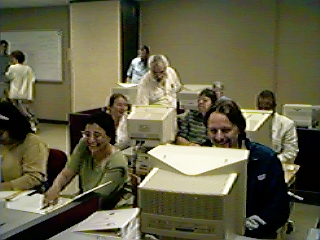
The morning of the first day of the SCSI workshop began perfectly with a cool yet sunny day and a big breakfast. The first order of business was to see what the participants thought that a piece of rope and a rubber ball modelled. The rope could, in the participant's eyes, model rope (of course), a bird, an orbit, endoplasmic reticulum, a subway system, DNA, or the genesis of both chaos and cooperation. The ball could be a model of a ball(who would've thunk it?), Earth, or a planet for its spherical geometry, its bouncing to illustrate consevation of energy- momentary damped oscillation, or a cell's nucleus with endoplasmic reticulum. Next we went to Monte Hall's doors. This dealt with percieved reality/probability versus true reality/probability. The idea is that you have three doors. Behind two of the doors are smelly pigs, but behind door number three (wherever that might be) is, what else?, MONEY!! You choose a door (each door having a 33% chance of having the money), and Monte tells you which one of the other doors has a pig behind it. Monte, with his two doors, has 66% of the money odds. Therefore, even though he removed a door, he still holds 66% of the odds. You can choose to stand (keep you own door) or take his door. As the odds are in his favor, it is always best to take his door. This brought up the idea that prehaps all everything is not as it seems. What if results or odds in a model are rigged? The model is no longer accurate, so it is no longer useful. We also explored the Application-Architecture-Algorithm pyramid and the included subgroups computation, theory, and experimentation. After that it was on to the progression from noise, to a signal, to data, to information, to Knowledge, and finally arriving at Truth. But the path to finding the Truth must be started with some kind of a WOW! reaction that begins your interest. Then the true scientist is drawn on by the Why?. Once the Truth is discovered the third question comes into play: Who Cares?
Upon returning for lunch, the participants were back in the lab to complete the scavenger hunt. With more experience warning them of common blunders, the groups turned to inventing strategies for speed. They discovered that the search went faster if groups divided up the topics. Then, in the lecture hall, Dr. Robert Panoff presented the agenda for the workshop, and stated the goals and approaches. There are three approaches to getting a working model, he told participants, and the workshop would explore all three to one degree or another. The veterinary model ("Poke it 'til it bites!") includes finding a model on the web and testing it to see if it actually works and is useful. The NASCAR model involves taking an existing, working model and modifying it to be specific to a purpose. The architect model refers to modeling from scratch. Next, the Shodor web site was discussed as a source of information, and the discussion moved to search engines and finding other sources of information. Shodor staff related anecdotes to demonstrate that off-web sources could also be useful. Dr. Stevenson focused attention back on the scavenger hunt, and tricks to make searching more effective. Overspecifying a search, he said, was a common error. He also suggested internal search engines, personal hotlink pages of academic faculty, and sites like Amazon and Webcats as places to begin searches more specifically. Dr. Panoff pointed out that NIH and NSF both have internal search engines. Then he warned participants that search engines search only a database they have collected, and do not search the Web in real time, so there is a delay between a site's appearance on the Web and the site's appearance on a search engine page... a delay of a day, a week, six months... After this, Dr. Panoff displayed an example of a model found off the web: a Java applet of molecular dynamics. A short break refreshed the group. As they returned to the lecture hall, Dr. Panoff introduced the idea of locally-running vs. client-server programs. He showed a page with a program for graphing simple functions, like a sine function, which does all its calculations on a computer across town. A participant asked how Shodor stored all the possible result pages; Dr. Panoff explained that the calculations and web page generation were done in real time. He demonstrated how an interactive model could be useful to a student of medicine, showing the group a model of baroreceptors. The example demonstrated not only how parts of the heart and nervous system worked, but also how different mean and instantaneous values could be. Dr. Panoff described and showed an application in literature -- a model of Edgar Allan Poe's story "The Pit and the Pendulum". How much error do approximations cost? He closed with two versions of a program called Snowflake, one in Java and one a standalone program. 
|